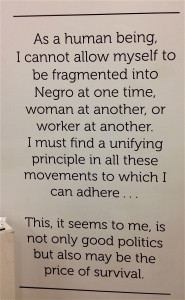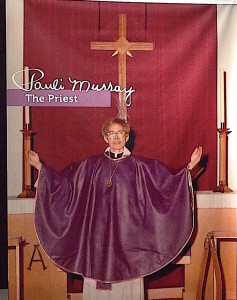January 11, 2017: Great news for Pauli Murray fans: in the last days of the Obama administration, the Secretary of the Interior, Sally Jewell, signed the declaration making Pauli Murray’s home in Durham NC a national historic landmark. The Pauli Murray website is here.
Why is this good news? The post below, from late 2015, begins to sketch out Pauli Murray’s story.:
Yesterday I was reminded that November 20 is Pauli Murray’s birthday — her 105th, to be precise.

And who is Pauli Murray, a few of you may ask?She was — and is — many things. One of them is my neighborhood saint.
Yes, she spent most of her childhood just a couple blocks from my place, in a house we’ll see in a moment.
But neighborhood bragging rights are only a small part of it. A major exhibit about her is up at a nearby place called The Scrap Exchange (a very interesting and unique project itself; but that’s another story), and yesterday I re-visited it, with some folks from my Carolina posse.

We were all completely smitten by her, yet again. So let’s get a few facts out there:
Pauli Murray was born in 1910, in Baltimore, but soon afterward orphaned, she came to Durham NC and was raised by aunts and grandparents.
Thereafter, in her life she was, among other things (hang on to your hats!) —
— a pioneering civil rights crusader, who had a big hand in the behind the scenes work on the landmark 1954 Brown Supreme Court desegregation decision;
— a pioneering modern American feminist, even if many feminist-identified folks never heard of her (tsk tsk if you haven’t); she was even a founder of the National Organization of Women;
— a pioneering women’s lawyer, who helped put gender equality in the great 1964 Civil Rights Act;

— a pioneer in bending and busting the boundaries of gender; kind of a lesbian, kind of not, kind of trans, kind of not, all and none of the above;
–and a pioneer in religion, the first black American woman ordained a priest in the Episcopal church; and
— yes, as of the summer of 2012, eighteen years after her death in 1985, she was declared a saint by the Episcopal church (her gender nonconformity notwithstanding).
That’s for starters. (Sorry if I said “pioneering” so many times, but that’s just what Pauli was for most of her life.)
 But how did these fragments and competing impulses (this is only a partial list) get knitted together for her? In a surprising way.
But how did these fragments and competing impulses (this is only a partial list) get knitted together for her? In a surprising way.
Her path is the main subject of the Scrap Exchange exhibit. And in marking it out, the display uses names that Pauli chose for herself, in her reflective writing, including “Imp,” “Dude,” and “Crusader.” All these fit well enough. Yet after six-plus tumultuous decades, these and other aspects of her life ultimately came together in religion: she had been a “church lady” all her life, but only after she was 60 did she decide to join the push for ordaining women in her Episcopal church by becoming a priest herself.
Religion: Pauli Murray the priest brought her identities together.

She told this story in her Autobiography. She also told the powerful story of her family in a group memoir, “Proud Shoes.”
Now, besides the exhibit, the Pauli Murray Project is working to make Pauli Murray’s remarkable life and work better known. And to do that, besides the exhibit, they want to turn her family home into a national historical landmark.
That work has started, and of course more funds and supporters are needed.

So our posse moved from the exhibit several blocks away and visited the house.

The original house, from which a century of additions and siding and repairs is all being scraped away and removed, is not exactly in its best condition right now. But its renewal is underway, one board, one brick at a time.

From this house, members of her family struggled against segregation, and for the education of freed people, and their full entry into society, against often very steep odds. And Pauli Murray’s remarkable, multi-faceted career, will make it a landmark, a resource, and a font of inspiration for many “causes,” for many struggles. As this display seeks to summarize it:

